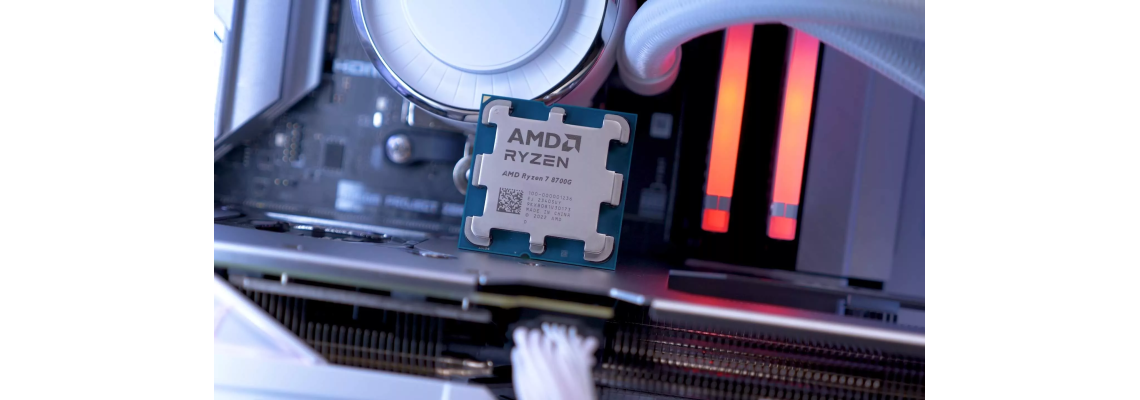
AMD Ryzen 7 8700G Review: The Most Powerful Integrated GPU Yet
The 8700G is part of the Zen 4, Zen 7000-class processor family, which also includes the Radeon 700M GPU in the same chip. This integrated graphics portion of the processor is based on RDNA 3 architecture and uses up to twelve compute units. AMD claims that these iGPUs are powerful enough to play most PC games at 1080p resolution.
So far, this is the best-integrated graphics available in a desktop CPU. But will this new APU be able to compete with your graphics card? Let's find out in this review.
AMD has announced four new Ryzen 8000G series chips so far. Today we’re going to focus on the 8700G.
The 8700G comes with 8 cores / 16 threads and clocks up to 5.1 GHz. The TDP is 65 watts. It’s built on a 4nm process and the cores are built on Zen 4 architecture. Because it’s a monolithic design and it also includes a relatively large GPU, some things like the cache capacity have been sacrificed in comparison to the standard Ryzen 7 7000 series.
For example, the Ryzen 8700G has a 16MB L3 cache and an 8MB L2 cache. The Ryzen 7 7700, on the other hand, has a 32MB L3 cache but an 8 MB L2 capacity.
The RDNA 2 GPU in the Ryzen 7 7700 has only 2 cores and a 2.2 GHz boost clock, while the RDNA 780M in the 8700G has 12 cores and a RDNA 3 GPU with a 2.9 GHz boost clock. As a result, you can expect a lot more out of the 8700G’s integrated graphics.
On the PCIe bus, there are even more distinctions. The Ryzen 7700 has a total PCIe 5.0 bandwidth of 28 lanes, four of which are dedicated to connecting the chipset. Meanwhile, the 8700G has a total PCIe bandwidth of just 20 lanes, all of which are PCIe 4.0, meaning that the primary PCIe slot has a maximum of eight lanes of PCIe 4.0 available. The 7700, on the other hand, has a total PCIe of 16 lanes.
In addition to the Ryzen 7700, the Ryzen 8700G comes with "Ryzen AI." This is AMD's first dedicated AI engine for a desktop processor. It uses the company's XDNA architecture, which has a clock speed of 1.6 GHz. This AI engine is separate from the CPUs and GPU cores we just looked at, and can be thought of as an NPU (Neural Processing Unit).
However, how helpful this hardware AI implementation will be to you is unclear at this stage, and since we tend to focus on gaming, we won’t be going into AI benchmarks right now. In addition, anyone who wants to use AI on a desktop machine would likely buy a discrete GPU, which is much more efficient for AI workloads.
Benchmarks
Let’s begin with some basic application benchmarking. First, let’s take a look at Cinebench’s single-core test and compare the 8700G to the 5700G, 7700, and 14700K. The 8700G achieves 111 fps, which is 21% faster than 5700G and 5% slower than 7700, but 15% slower than 14700K.
Now, let’s take a look at the multi-core numbers. The 8700G matches the 7700 in terms of multi-threaded performance, which is to be expected since they’re both 8 core/16 thread Zen 4 processors. Things like cache capacity, memory performance, etc. only play a marginal role in this comparison. The 5700G is 37% more multi-threaded than the 8700, and it’s a whopping 144% more multi-core than the 8700F, which we’ll come back to in more detail as we progress through the gaming benchmarks.
for decompression, it's just 8% faster than the 5700G and 12% slower than the 7700.
When it comes to Photoshop performance, we're looking at a 34% improvement over the 5700G, marking a significant uplift. Meanwhile, the 8700G was just 6% slower than the 7700.
iGPU Gaming Benchmarks
Time to look at gaming performance, and we're starting with the integrated graphics because this is what makes the 8700G special. For all these benchmarks, we're looking to test at 1080p low-quality setting gaming as this is integrated graphics after all.
Memory Scaling Performance
Before we dive into discrete GPU benchmarking, let’s talk about memory scaling performance. To test this, we used a 1:1 memory kit (DDR5-6400) with a 2400 MHz full-child-child (FCLK) clock. This isn’t necessarily the best configuration, but AMD claims that all CPUs will meet this specification.
AMD also states that most CPUs will meet the 1:2 ratio for DDR5-77200, which can be helpful. This is important since memory bandwidth is critical for iGPU performance. The priorities here are different from the ones you’d see on a Ryzen 7000 series CPU, where you’d normally focus on latency.
Conclusion
For those of you who want to jump on the AM5 platform, consider getting a Ryzen 5 7600 for $230 and pairing it with a Radeon RX 6600 or better. For a total of $430, your experience is going to be significantly better. It's a 30% premium for ~150% greater performance.
The idea of a gaming APU for budget users always sounds great, but in practice, they're just never fast enough. More affordable discrete combos always deliver significantly better performance, and we don't expect this to change any time soon.
